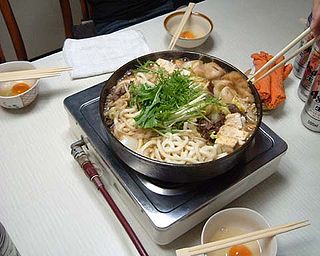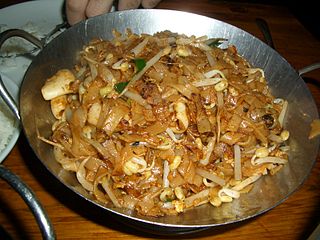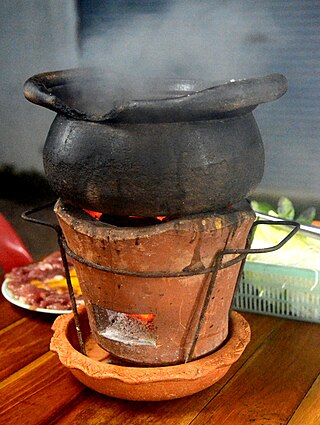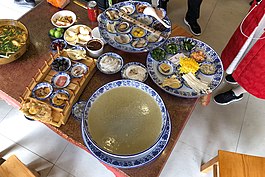
Nabemono, or simply nabe, is a variety of Japanese hot pot dishes, also known as one pot dishes and "things in a pot".

Malaysian cuisine consists of cooking traditions and practices found in Malaysia, and reflects the multi-ethnic makeup of its population. The vast majority of Malaysia's population can roughly be divided among three major ethnic groups: Malays, Chinese and Indians. The remainder consists of the indigenous peoples of Sabah and Sarawak in East Malaysia, the Orang Asli of Peninsular Malaysia, the Peranakan and Eurasian creole communities, as well as a significant number of foreign workers and expatriates.

Malaysian Chinese cuisine is derived from the culinary traditions of Chinese Malaysian immigrants and their descendants, who have adapted or modified their culinary traditions under the influence of Malaysian culture as well as immigration patterns of Chinese to Malaysia. Because the vast majority of Chinese Malaysians are descendants of immigrants from southern China, Malaysian Chinese cuisine is predominantly based on an eclectic repertoire of dishes with roots from Fujian, Cantonese, Hakka and Teochew cuisines.

Pancit, also spelled pansít, is a general term referring to various traditional noodle dishes in Filipino cuisine. There are numerous types of pancit, often named based on the noodles used, method of cooking, place of origin, equal and constant diameter or the ingredients. Most pancit dishes are characteristically served with calamansi, which adds a citrusy flavor profile.

Noodle soup refers to a variety of soups with noodles and other ingredients served in a light broth. Noodle soup is a common dish across East Asia, Southeast Asia and the Himalayan states of South Asia. Various types of noodles are used, such as rice noodles, wheat noodles and egg noodles.

Chinese Indonesian cuisine is characterized by the mixture of Chinese with local Indonesian style. Chinese Indonesians, mostly descendant of Han ethnic Hokkien and Hakka speakers, brought their legacy of Chinese cuisine, and modified some of the dishes with the addition of Indonesian ingredients, such as kecap manis, palm sugar, peanut sauce, chili, santan and local spices to form a hybrid Chinese-Indonesian cuisine. Some of the dishes and cakes share the same style as in Malaysia and Singapore, known as Nyonya cuisine by the Peranakan.

Rice vermicelli is a thin form of noodle. It is sometimes referred to as "rice noodles" or "rice sticks", but should not be confused with cellophane noodles, a different Asian type of vermicelli made from mung bean starch or rice starch rather than rice grains themselves.

Rice noodles are noodles made with rice flour and water as the principal ingredients. Sometimes ingredients such as tapioca or corn starch are added in order to improve the transparency or increase the gelatinous and chewy texture of the noodles. Rice noodles are most common in the cuisines of China, India and Southeast Asia. They are available fresh, frozen, or dried, in various shapes, thicknesses and textures. Fresh noodles are also highly perishable; their shelf life may be just several days.

Peranakan cuisine or Nyonya cuisine comes from the Peranakans, descendants of early Chinese migrants who settled in Penang, Malacca, Singapore and Indonesia, inter-marrying with local Malays. In Baba Malay, a female Peranakan is known as a nonya, and a male Peranakan is known as a baba. The cuisine combines Chinese, Malay, Javanese, South Indian, and other influences.

Soups in East Asian culture are eaten as one of the many main dishes in a meal or in some cases served straight with little adornment, particular attention is paid to the soups' stocks. In the case of some soups, the stock ingredients become part of the soup. They are usually based solely on broths and lacking in dairy products such as milk or cream. If thickened, the thickening usually consists of refined starches from corn or sweet potatoes.

Guizhou cuisine, or Qian cuisine, consists of cooking traditions and dishes from Guizhou Province in southwestern China. Guizhou cuisine shares many features with Sichuan cuisine and Hunan cuisine, especially in bringing the sensation of spiciness and pungency. What makes Guizhou cuisine unique is the emphasis of a mixed sour-and-spicy taste, as compared to the numbing-and-hot sensation featured in Sichuan cuisine and the dry-hot taste featured in Hunan cuisine. There is an ancient local saying, "Without eating a sour dish for three days, people will stagger with weak legs". The saying reflects how Guizhou people love local dishes with a sour taste. The combination of sour and spicy flavours is also found in Shaanxi cuisine. Guizhou cuisine differs from Shaanxi cuisine in that it lacks the emphasis on the salty taste, which is a common trait found in most northern Chinese cuisines. In addition, the unique sourness featured in Guizhou cuisine comes from the local tradition of fermenting vegetables or grains, and not from using vinegar products.

Lontong is an Indonesian dish made of compressed rice cake in the form of a cylinder wrapped inside a banana leaf, commonly found in Indonesia, Malaysia, and Singapore. Rice is rolled inside a banana leaf and boiled, then cut into small cakes as a staple food replacement for steamed rice. The texture is similar to that of ketupat, with the difference being that the ketupat container is made from woven janur fronds, while lontong uses banana leaf instead.

Javanese cuisine is the cuisine of Javanese people, a major ethnic group in Indonesia, more precisely the province of Central Java, Yogyakarta and East Java.
Ohn no khao swè is a Burmese dish consisting of wheat noodles in a curried chicken and coconut milk broth thickened with gram flour. It features wheat noodles in a rich broth made with curried chicken and coconut milk, thickened with gram flour. Crispy fried bean fritters, hard-boiled eggs, sliced raw onions, chili peppers, and crispy noodles are added to the dish. Fish sauce and lime or lemon juice are then drizzled over everything.

Chim chum is a Southeast Asian street food, popular especially in Thailand. It is traditionally made with chicken or pork and fresh herbs such as galangal, sweet basil, lemongrass and kaffir lime leaves, cooked in a small clay pot on a charcoal stove. It is often served with nam chim.

Betawi cuisine is rich, diverse and eclectic, in part because the Betawi people that create them were composed from numbers of regional immigrants that came from various places in the Indonesian archipelago, as well as Chinese, Indian, Arab, and European traders, visitors and immigrants that were attracted to the port city of Batavia since centuries ago.

Indonesian noodles are a significant aspect of Indonesian cuisine which is itself very diverse. Indonesian cuisine recognizes many types of noodles, with each region of the country often developing its own distinct recipes.
















